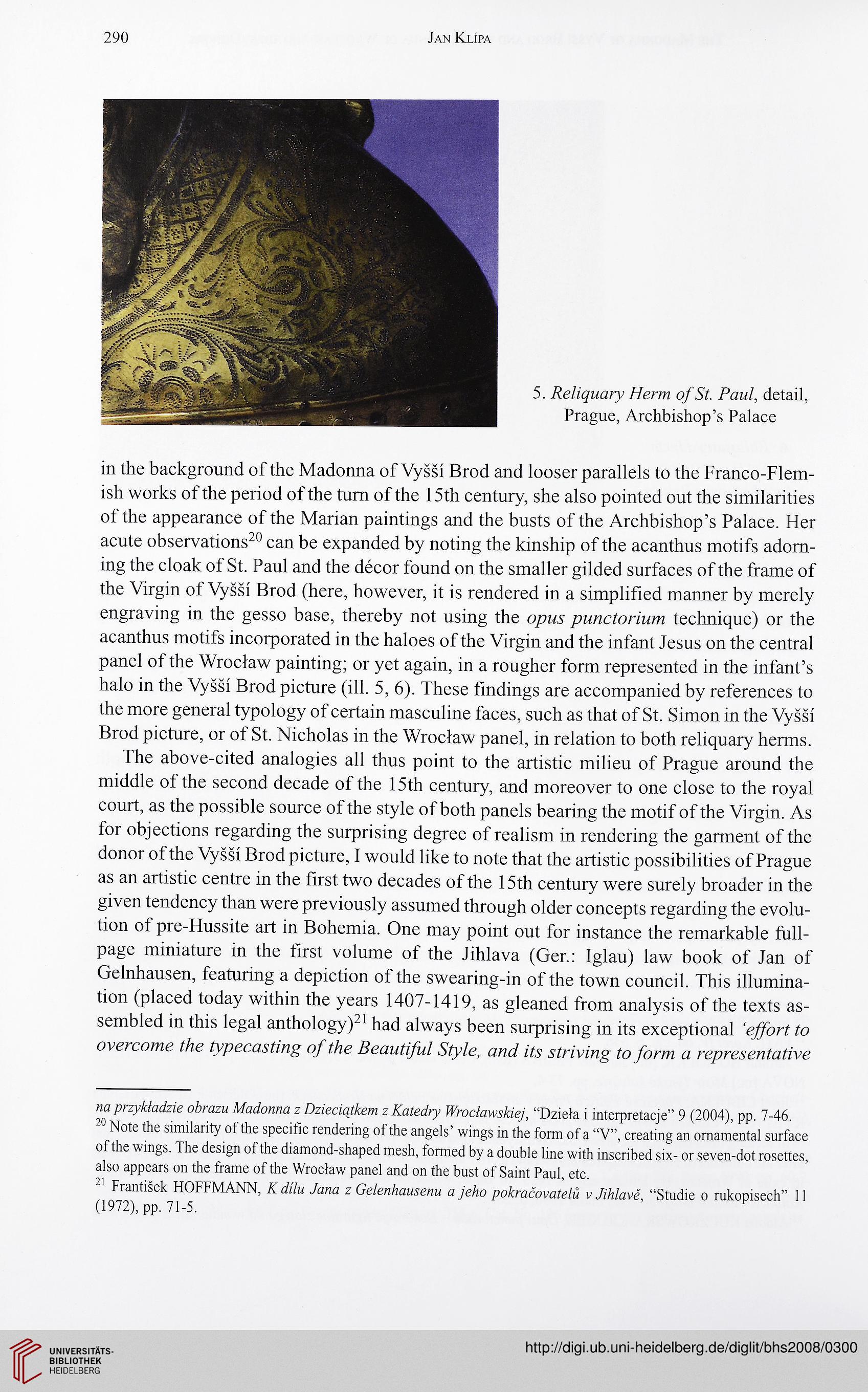290
JAN KLIPA
5. /Zerw o/ÂSÏ. /Am/, detail,
Prague, Archbishop's Palace
in the background of the Madonna of Vyssi Brod and looser parallels to the Franco-Flem-
ish works of the period of the tum of the 15th century, she also pointed out the similarities
of the appearance of the Marian paintings and the busts of the Archbishop's Palace. Her
acute observations-^ can be expanded by noting the kinship of the acanthus motifs adorn-
ing the cloak of St. Paul and the décor found on the smaller gilded surfaces of the frame of
the Virgin of Vyssi Brod (here, however, it is rendered in a simplified manner by merely
engraving in the gesso base, thereby not using the /mnc/crmm technique) or the
acanthus motifs incorporated in the haloes of the Virgin and the infant Jesus on the central
panel of the Wroclaw painting; or yet again, in a rougher form represented in the infant's
halo in the Vyssi Brod picture (ill. 5, 6). These findings are accompanied by references to
the more general typology of certain masculine faces, such as that of St. Simon in the Vyssi
Brod picture, or of St. Nicholas in the Wroclaw panel, in relation to both reliquary herms.
The above-cited analogies all thus point to the artistic milieu of Prague around the
middle of the second decade of the 15th century, and moreover to one close to the royal
court, as the possible source of the style of both panels bearing the motif of the Virgin. As
for objections regarding the surprising degree of realism in rendering the garment of the
donor of the Vyssi Brod picture, I would like to note that the artistic possibilities of Prague
as an artistic centre in the first two decades of the 15th century were surely broader in the
given tendency than were previously assumed through older concepts regarding the evolu-
tion of pre-Hussite art in Bohemia. One may point out for instance the remarkable full-
page miniature in the first volume of the Jihlava (Ger.: Iglau) law book of Jan of
Gelnhausen, featuring a depiction of the swearing-in of the town council. This illumina-
tion (placed today within the years 1407-1419, as gleaned from analysis of the texts as-
sembled in this legal anthology)"' had always been surprising in its exceptional A?
ovgrcowz? //?<? (ypgcaVmg o/ //?<? A/yA, mm/ /A WAwAg At /orm <3
na przyÆA&m o&azM AAAw/M z DzAdqtAw z /Af-Vy ITvc/awW'e/, "Dzieła i interpretacje" 9 (2004), pp. 7-46.
Note the similarity of the specific rendering of the angels' wings in the form of a "V", creating an ornamental surface
of the wings. The design of the diamond-shaped mesh, formed by a double line with inscribed six- or seven-dot rosettes,
also appears on the frame of the Wroclaw panel and on the bust of Saint Paul, etc.
Frantiśek HOFFMANN, AV/A J333 z 3 ye/zo y<Ar3<rov3?AM v7z7z/3ve, "Studie o rukopisech" 11
(1972), pp. 71-5.
JAN KLIPA
5. /Zerw o/ÂSÏ. /Am/, detail,
Prague, Archbishop's Palace
in the background of the Madonna of Vyssi Brod and looser parallels to the Franco-Flem-
ish works of the period of the tum of the 15th century, she also pointed out the similarities
of the appearance of the Marian paintings and the busts of the Archbishop's Palace. Her
acute observations-^ can be expanded by noting the kinship of the acanthus motifs adorn-
ing the cloak of St. Paul and the décor found on the smaller gilded surfaces of the frame of
the Virgin of Vyssi Brod (here, however, it is rendered in a simplified manner by merely
engraving in the gesso base, thereby not using the /mnc/crmm technique) or the
acanthus motifs incorporated in the haloes of the Virgin and the infant Jesus on the central
panel of the Wroclaw painting; or yet again, in a rougher form represented in the infant's
halo in the Vyssi Brod picture (ill. 5, 6). These findings are accompanied by references to
the more general typology of certain masculine faces, such as that of St. Simon in the Vyssi
Brod picture, or of St. Nicholas in the Wroclaw panel, in relation to both reliquary herms.
The above-cited analogies all thus point to the artistic milieu of Prague around the
middle of the second decade of the 15th century, and moreover to one close to the royal
court, as the possible source of the style of both panels bearing the motif of the Virgin. As
for objections regarding the surprising degree of realism in rendering the garment of the
donor of the Vyssi Brod picture, I would like to note that the artistic possibilities of Prague
as an artistic centre in the first two decades of the 15th century were surely broader in the
given tendency than were previously assumed through older concepts regarding the evolu-
tion of pre-Hussite art in Bohemia. One may point out for instance the remarkable full-
page miniature in the first volume of the Jihlava (Ger.: Iglau) law book of Jan of
Gelnhausen, featuring a depiction of the swearing-in of the town council. This illumina-
tion (placed today within the years 1407-1419, as gleaned from analysis of the texts as-
sembled in this legal anthology)"' had always been surprising in its exceptional A?
ovgrcowz? //?<? (ypgcaVmg o/ //?<? A/yA, mm/ /A WAwAg At /orm <3
na przyÆA&m o&azM AAAw/M z DzAdqtAw z /Af-Vy ITvc/awW'e/, "Dzieła i interpretacje" 9 (2004), pp. 7-46.
Note the similarity of the specific rendering of the angels' wings in the form of a "V", creating an ornamental surface
of the wings. The design of the diamond-shaped mesh, formed by a double line with inscribed six- or seven-dot rosettes,
also appears on the frame of the Wroclaw panel and on the bust of Saint Paul, etc.
Frantiśek HOFFMANN, AV/A J333 z 3 ye/zo y<Ar3<rov3?AM v7z7z/3ve, "Studie o rukopisech" 11
(1972), pp. 71-5.




